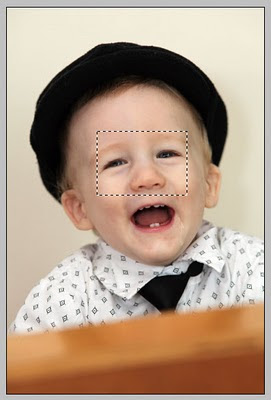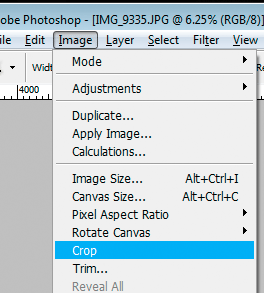Getting a really big print done for the first time is as scary as hell, isn't it? It's really expensive, and you're afraid that you'll blow your dough because the shot isn't good enough, or your camera doesn't have enough megapixels.
First, I want to point you to my article here:
How big can I print my photo? You'll find it puts your mind at ease.
Secondly, I want to talk about the practical solution - getting a
small test print done first. Taking a small centre crop of the full-size image is a very cheap way to see how your large print will turn out.
Step One: The usual stuff
Edit your photo in the normal way. Save it as a PSD (or whatever), and don't crop or resize it at all. That's your master file.
Don't sharpen it - that's vitally important.
Step Two: Resize for print
Prepare your file for printing big. Resize it to the desired size (let's say 20x30") at the resolution recommended by your lab (eg 300ppi ... or maybe unchanged). Flatten the layers, too, if necessary. Don't sharpen yet!
Step Three: Take a centre crop
Decide what size test print you'd like. Obviously a 6x4 is cheapest, but is that enough? Maybe a 5x7 or an 8x10 is better, to show you more of the image. Choose the biggest test size you think you can afford, without blowing the budget.
Choose your Marquee Tool
(a), set it to "Fixed Size"
(b) and enter the size of your intended test print
(c):

Click in the image to draw the marquee, then drag it to where you want it (usually eyes, if it's a portrait):

Choose "Crop" from the Image menu:

And there you have it! A real-size centre-crop test print.
Step Four: Sharpen
The biggest hassle about printing big is how much to sharpen. I think it's a good idea to get at least two test prints done, with different sharpness settings, to see what looks best. An under-sharpened print would be a little disappointing, but an over-sharpened one would be a disaster.
So I recommend duplicating the test print file once or twice, and sharpening each one differently. It doesn't matter how you sharpen (USM, High Pass, actions, whatever), but you should try at least an aggressive and a mild sharpened version, or an aggressive, a moderate, and a mild version.
IMPORTANT: Make sure you use the text tool to make a note on the corner of each image about the sharpening settings you've used. Otherwise you'll get the test prints back, and say "I love that one ... I wish I could remember what I did!"
Step Five: Save 'em and send 'em
Save the test print files as jpegs (at whatever quality setting you usually use), and send them off to the lab. Go and spend some time with loved ones for a day or so until they come back.
Step Six: Evaluate
When you get the test prints back, it's time to see how they look.
ULTRA IMPORTANT: For heaven's sake, don't examine them up close like you would a normal small print. Stick them to the wall and take a few paces back, and evaluate them the way you'd evaluate the magnificent large print. Pixel-peepers never got any joy from rubbing their noses on a large print, I assure you.
Decide which level of sharpening you like, and go ahead and apply that to the full-size file.
Step Seven: Print the big one, and bask in the glory!
Send the big file off to print, and wait eagerly for it to be ready. Trust me, you'll love it!!!
 Click in the image to draw the marquee, then drag it to where you want it (usually eyes, if it's a portrait):
Click in the image to draw the marquee, then drag it to where you want it (usually eyes, if it's a portrait):
 Choose "Crop" from the Image menu:
Choose "Crop" from the Image menu:
 And there you have it! A real-size centre-crop test print.
Step Four: Sharpen
The biggest hassle about printing big is how much to sharpen. I think it's a good idea to get at least two test prints done, with different sharpness settings, to see what looks best. An under-sharpened print would be a little disappointing, but an over-sharpened one would be a disaster.
So I recommend duplicating the test print file once or twice, and sharpening each one differently. It doesn't matter how you sharpen (USM, High Pass, actions, whatever), but you should try at least an aggressive and a mild sharpened version, or an aggressive, a moderate, and a mild version.
IMPORTANT: Make sure you use the text tool to make a note on the corner of each image about the sharpening settings you've used. Otherwise you'll get the test prints back, and say "I love that one ... I wish I could remember what I did!"
Step Five: Save 'em and send 'em
Save the test print files as jpegs (at whatever quality setting you usually use), and send them off to the lab. Go and spend some time with loved ones for a day or so until they come back.
Step Six: Evaluate
When you get the test prints back, it's time to see how they look.
ULTRA IMPORTANT: For heaven's sake, don't examine them up close like you would a normal small print. Stick them to the wall and take a few paces back, and evaluate them the way you'd evaluate the magnificent large print. Pixel-peepers never got any joy from rubbing their noses on a large print, I assure you.
Decide which level of sharpening you like, and go ahead and apply that to the full-size file.
Step Seven: Print the big one, and bask in the glory!
Send the big file off to print, and wait eagerly for it to be ready. Trust me, you'll love it!!!
And there you have it! A real-size centre-crop test print.
Step Four: Sharpen
The biggest hassle about printing big is how much to sharpen. I think it's a good idea to get at least two test prints done, with different sharpness settings, to see what looks best. An under-sharpened print would be a little disappointing, but an over-sharpened one would be a disaster.
So I recommend duplicating the test print file once or twice, and sharpening each one differently. It doesn't matter how you sharpen (USM, High Pass, actions, whatever), but you should try at least an aggressive and a mild sharpened version, or an aggressive, a moderate, and a mild version.
IMPORTANT: Make sure you use the text tool to make a note on the corner of each image about the sharpening settings you've used. Otherwise you'll get the test prints back, and say "I love that one ... I wish I could remember what I did!"
Step Five: Save 'em and send 'em
Save the test print files as jpegs (at whatever quality setting you usually use), and send them off to the lab. Go and spend some time with loved ones for a day or so until they come back.
Step Six: Evaluate
When you get the test prints back, it's time to see how they look.
ULTRA IMPORTANT: For heaven's sake, don't examine them up close like you would a normal small print. Stick them to the wall and take a few paces back, and evaluate them the way you'd evaluate the magnificent large print. Pixel-peepers never got any joy from rubbing their noses on a large print, I assure you.
Decide which level of sharpening you like, and go ahead and apply that to the full-size file.
Step Seven: Print the big one, and bask in the glory!
Send the big file off to print, and wait eagerly for it to be ready. Trust me, you'll love it!!!